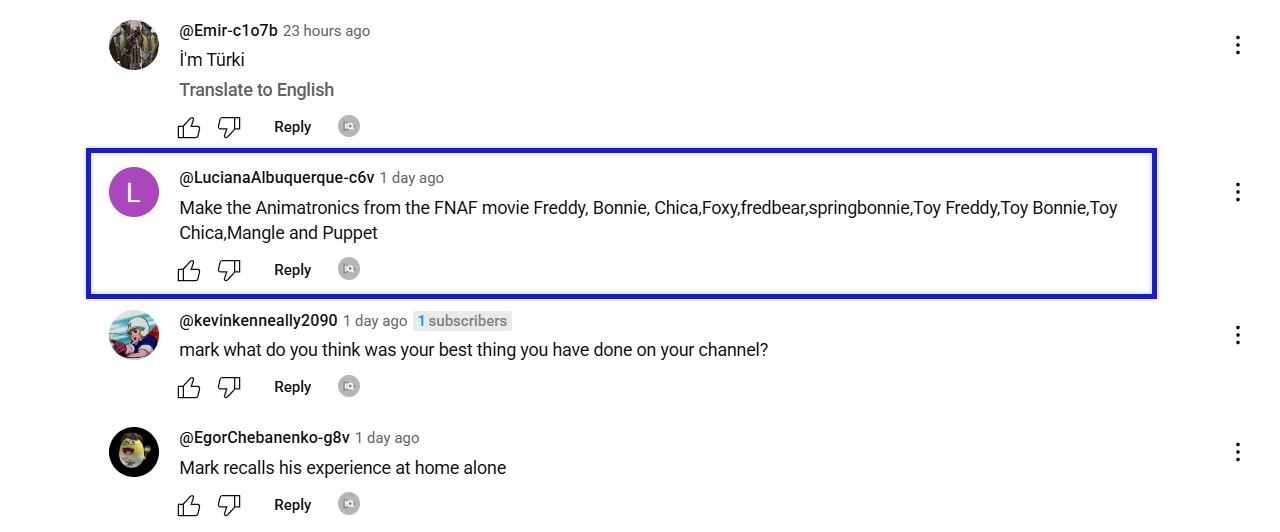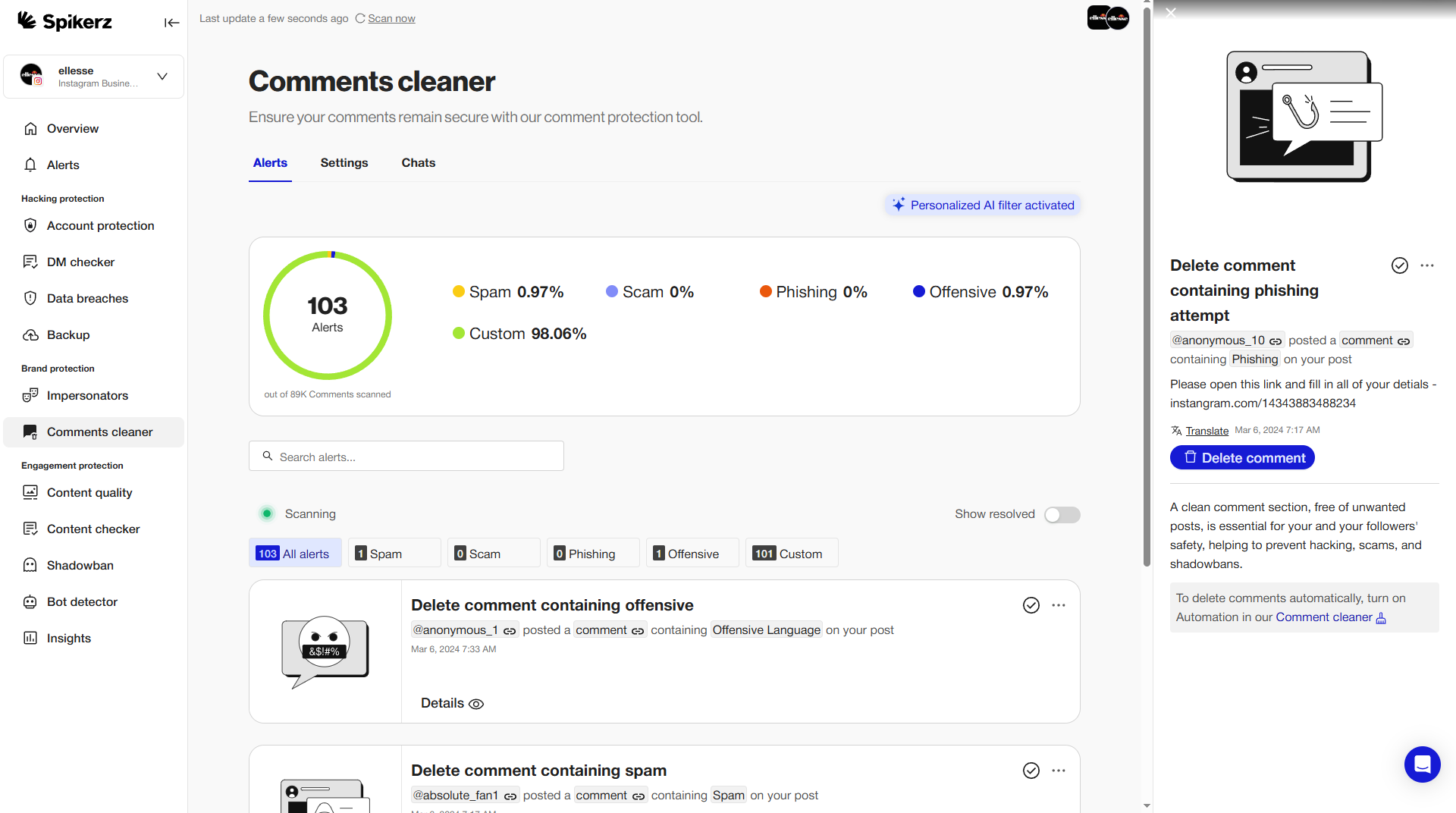What Is Comment Spamming? How Does It Work?
Getting a flood of unwanted or irrelevant comments can easily overwhelm moderators and annoy your audience, leading to important customer and prospect questions, feedback, and legitimate leads to get buried and overlooked.
As a result, your team spends countless hours manually removing these comments instead of focusing on growth initiatives. Your customers get frustrated when their questions get buried beneath layers of spam and fake giveaways.
Does that sound familiar?
Well, don’t worry because in this post, we'll go over what comment spamming is, why it's terrible for your social media accounts, the different types of spam you'll encounter, and how to deal with them effectively using both built-in platform tools and specialized security solutions.
What Is Comment Spamming?

Comment spamming is when people post unsolicited, irrelevant, or promotional comments on online platforms like blogs, forums, and social media. These comments have no legitimate purpose for your audience and often interfere with genuine conversations happening around your content.
Their main goal is often to generate backlinks to the spammer's own website or social media profile, to promote their products or services, often in a deceptive or misleading manner.
Another common reason for spam comments is to promote scams. This is something we see all the time on platforms like YouTube and Instagram and it's something businesses should pay close attention to. These comments often target your followers with fake investment opportunities, cryptocurrency schemes, or fake giveaways that can damage your brand's reputation when they show up on your posts.
Why Spam Comments Are Terrible For Your Social Media Account
Comment spamming is more problematic than you might think. These messages create multiple issues that directly impact your brand's online presence and your ability to connect with your audience. Here are some reasons why you should get rid of them immediately:
Degrades Content Quality
One of the biggest problems with spam comments is that they clutter up comment sections and make it harder for users to find valuable information. When your posts receive dozens of promotional messages and irrelevant links, your community members struggle to locate meaningful discussions and responses to their questions.
It also discourages engagement from people who are actually interested in having a conversation. Users see a comment section full of spam and assume your community isn't worth participating in, leading to decreased organic engagement over time.
May Lead To Security Risks
Another dangerous use of spam comments is spreading malware or phishing for user information. Spammers often include malicious links disguised as legitimate websites, tricking your followers into clicking on dangerous content that can compromise their personal data or devices.
Unfortunately, this form of spam is common in large communities and it often leads to financial losses, brand damage, and trust lost. When your followers fall victim to these scams, they may blame your brand for not protecting them.
Disrupts Genuine Conversations
Spam comments can easily derail discussions and make it difficult for users to interact. When promotional messages and irrelevant content dominate your comment sections, genuine conversations between community members get pushed down or lost entirely.
These comments don't add any value so they should be removed or hidden immediately. Allowing spam to continue signals to your audience that you don't actively monitor your community, which can damage trust and reduce future engagement.
Types of Comment Spamming
There are many different types of spam comments on social media, some are more in your face than others, but in the end, they are all not something we want to see in our comment sections. Here are the different types of comments you’ll encounter:
1. Promotional Spam

This is one of the most common types of spam messages we see online. These comments promote unrelated products, services, or links that have nothing to do with your content or your audience's interests.
The big problem with these types of messages is that they are often posted by bots or fake accounts so they are able to publish thousands of comments in minutes. As such, it's hard to keep up with how fast they show up in our comment sections, especially during peak engagement hours when your posts are gaining traction.
That said, these types of comments are easy to identify because… as we said, they promote unrelated products, services, or links. They often include phrases like "Check out my profile" or "Amazing opportunity here" followed by suspicious links or contact information.
2. Scam Links
These comments include links that are often disguised as legitimate URLs, tricking people into clicking them. Spammers use URL shorteners or create domains that closely resemble trusted websites to make their links appear safe and relevant.
Once people do, they are taken to phishing websites where they are asked to give up personal information or download malware. These fraudulent sites often mimic popular platforms like social media login pages, banking websites, or online shopping portals to steal credentials and financial information.
3. Fake Giveaways

Fake giveaways often impersonate brands and people to lure users with promises of free products, large sums of money, or investing in cryptocurrency scams. These comments typically claim users have "won" something they never entered or promise unrealistic rewards for simple actions.
These types of scams are very common on platforms like YouTube where scammers jump on to comment sections and reply to comments letting people know they've "won" something so they should contact them via Telegram to only then scam them. The scammers often use profile pictures and usernames that closely resemble legitimate brands or influencers to increase their credibility.
4. Mass Tagging
Mass tagging is the practice of mentioning multiple users in one comment to artificially boost credibility or draw their attention. These comments often include dozens of random usernames followed by promotional content or spam links.
The main issue with this type of spam comment is that it clutters the conversation, it is annoying to tagged users, and can cause your posts to be flagged for spam and deprioritized by social media algorithms. Tagged users who didn't consent to being mentioned may also report your content, leading to potential account restrictions.
5. Repetitive Comments
Repetitive messages are spammy because users post them across multiple accounts or pages, often pushing a specific message, link, or phrase. These comments appear identical or nearly identical across various posts and platforms, showing clear signs of automated or coordinated posting.
These types of messages can be part of coordinated spam campaigns and are designed to overwhelm moderation tools that rely on basic keyword filtering. Spammers often make slight variations to bypass automated detection while maintaining their core promotional message.
For example, some phrases you may see include:
- DM me for a sure way to make $5000 a week from home! Proof in my profile! (often with slight variations in the amount or timeframe)
- Claim your free gift card now! Limited time offer: [Scam link]
- Great post! Love your content. Check out my page too!
6. Offensive Comments
Sometimes spam comments aren't about sales or scamming users, sometimes it's "just" about provoking or offending people. This can include hate speech, slurs, inappropriate language, or simply unrelated nonsense meant to derail the conversation and upset your community members.
This kind of content can be damaging to your brand's image and alienating for your audience. That's why you should pay close attention to them and use advanced filters on social media platforms to deal with most of them before they impact your community's experience.
How To Deal With Spam Comments
Spam comments are a pain for any business or creator on social media, and of course there are multiple ways to manage them, like manual moderation, keyword filtering, or platform-specific settings, but the easiest and most effective solution is to use a social media security tool like Spikerz.

Spikerz is a cybersecurity platform that's focused on protecting your social media accounts against threats like hacking, phishing, and impersonation, but it also helps you manage your comments. Our platform goes beyond basic keyword filtering to understand context and intent behind.
Spikerz automatically detects, removes, and hides hate speech, scams, spam, and bot activity from comments and direct messages (DMs) through automated moderation. This means you don't have to manually review every suspicious comment or worry about spam overwhelming your community while you're focused on creating content.
It lets you create custom rules based on keywords, user behavior, and content type so you stay in control over your brand and your profile's engagement. You can set specific rules for what type of content gets flagged while allowing legitimate discussions to continue naturally.
With that said, here's how Spikerz help you clean your comments:
- Click the "Comments Cleaner" option in the menu under "Security."
- Click "Try now" on the Comments Cleaner page.
- Spikerz will scan your account for spam, phishing, offensive language, and scams. You'll see any issues in your dashboard.
- Choose your settings.
- Automatic filtering: The tool removes flagged comments instantly.
- Manual review: You check and remove flagged comments yourself.
- Next, pick which comments you want to filter:
- Spam: Catches unwanted promotional content
- Scams: Spots attempts to steal personal information
- Offensive language: Finds harmful or abusive comments
- Phishing: Identifies dangerous links
- Custom keywords: Filters specific words you choose
- Click "Save." You're all set!
Conclusion
Comment spamming is a growing threat to businesses and creators who depend on social media. These messages degrade content quality, create security risks, and disrupt genuine conversations that build strong communities around your brand.
The six types of comment spam we explored all share one common trait: they steal value from your audience and provide nothing useful in return. Manual moderation and basic platform tools simply can't keep pace with the volume of these attacks.
That’s why smart businesses protect their digital presence with specialized tools like Spikerz that automatically detect and eliminate spam before it damages their brand reputation. Your comment sections should be spaces where customers feel safe to engage, ask questions, and build relationships with your business, not battlegrounds against scammers and spammers.

